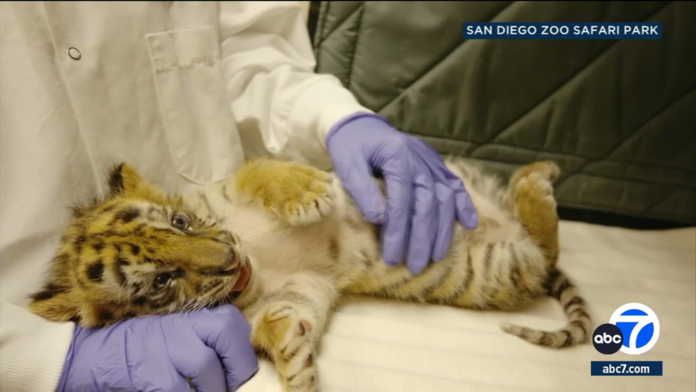After animals are seized from illegal traffickers at travel hubs like LAX – what happens next? A new network helps connect them with safe homes.
LOS ANGELES (KABC) — Illegal wildlife trafficking is a multibillion-dollar business. It’s high-profit and low-risk for smugglers – and Los Angeles is a hotspot in the global fight against the cruel trade that puts endangered animals’ lives at risk.
On Friday, a new program was launched to help endangered or threatened animals that are trafficked into Southern California.
“We stand here united to launch the Southern California Wildlife Confiscations Network, a collaborative effort that exemplifies the power of partnerships, compassion and dedication in safeguarding our planet’s precious wildlife,” said Denise Verret, CEO of the Los Angeles Zoo.
The Southern California Confiscations Network is a pilot program that connects law enforcement agencies like the U.S. Fish & Wildlife Service with qualified zoos, aquariums, universities, and animal rescues that are all standing by, ready to provide immediate care and housing for live, seized and often traumatized trafficked animals.
“Wildlife trafficking is often tied to other serious crimes,” said Manisa Kung, special agent in charge of the U.S. Fish and Wildlife Service. “It fuels criminal networks and impacts the security of our national and partner interests.”
“Trafficked wildlife are often shipped in very inhumane conditions. These animals are usually found in poor health, having been confined and concealed in ways that prevent them from moving, eating, or drinking – and subjected to extreme temperatures and shipping conditions.”
The U.S. Fish and Wildlife Service confiscated more than 50,000 illegally trafficked animals between 2015 and 2019. Fish and Wildlife agents are tasked with investigating the crime of trafficking, but also must figure out what to do with the live, trafficked animals.
“And so, the volume of animals that are really refugees from that illegal trafficking and trade is a huge problem for the Fish and Wildlife Service,” said Dan Ashe of the Association of Zoos and Aquariums.
“And it slows down their law enforcement efforts when have to take their time to find places to hold those animals. So this partnership is going to speed up law enforcement and it’s going to get the animals to places that know how to care for them.”
“That’s where we can really be of help and why zoos matter because we can say, oh – we can help this animal decompress from its 15-hour flight in somebody’s sock – or a Pringle’s can,” said Beth Schaefer, director of animal programs at the Los Angeles Zoo. “Law enforcement has to be paying attention to what is happening with all the evidence. They have to go catch the bad guy, literally.”
Eyewitness News got an inside look at a Southern California smuggling hot spot – LAX – and the teams of Fish and Wildlife agents searching airline cargo for illegally trafficked wildlife or animal products.
Fish and Wildlife Service agents are tasked with inspecting airline cargo at 12 warehouses at LAX every day. The volume of cargo is so high, they can only inspect about 8% of all shipments coming into the airport.
Agents get assistance from Braxton, a 3-year-old Labrador mix who is specially trained to sniff out trafficked animals or animal products.
“Imagine him being a big X-ray that can pinpoint what we’re looking for in any of these boxes,” says Braxton’s K-9 handler, Fish & Wildlife inspector Ray Hernandez.
In a training exercise, Braxton was able to sniff out boxed-up dried seahorses and a rhinoceros horn that Hernandez had hidden in the stacks of airline cargo.
“That’s a good boy, Braxton,” said Hernandez as the Labrador detected the illegal products.
Braxton was initially trained to detect five scents: Seahorses, sea turtles, python skin, rhinoceros horns and elephant ivory. Over time, Hernandez adds additional scents in response to what they may be seeing in cargo shipments, like shark fins, endangered sea cucumbers and live reptiles.
“The most trafficked animals that we find are reptiles,” Hernandez says. “Snakes, lizards, turtles. We see those animals a lot because they’re easier to traffic. They have lower metabolisms, they require less oxygen, less food, less water — a lot of those fundamental resources that birds and mammals would need. And they can survive longer in a confined space.”
The Fish & Wildlife Service showed Eyewitness News a display room filled with the preserved remains of hundreds of seized or donated endangered animals. Taxidermized tiger and leopard heads sit alongside turtles, koalas, a macaque monkey, a pangolin, and foot stools made out of elephant feet.
“Here are some primate skulls, they’re hard to identify,” Hernandez says. “It’s been adorned as some kind of curio.”
One trafficked animal that served as inspiration for the new Southern California Wildlife Confiscations Network is Moka, the Bengal tiger seized as a cub at the border near Tijuana in 2017. Moka was confiscated by U.S. Customs and Border Protection after a Perris man tried to smuggle him into the U.S. at the Otay Mesa border. Luis Eudoro Valencia was sentenced to six months in prison after pleading guilty to a charge of conspiracy to import tigers.
Moka was initially cared for by the San Diego Zoo and then transferred to the Lions, Tigers & Bears sanctuary near San Diego. Moka is now six years old, more than 300 pounds and thriving at his new home.




